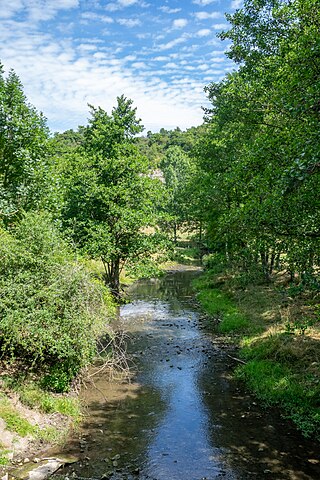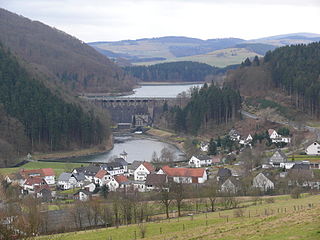
The Weser is a river of Lower Saxony in north-west Germany. It begins at Hannoversch Münden through the confluence of the Werra and Fulda. It passes through the Hanseatic city of Bremen. Its mouth is 50 km (31 mi) further north against the ports of Bremerhaven and Nordenham. The latter is on the Butjadingen Peninsula. It then merges into the North Sea via two highly saline, estuarine mouths.

The Lippe is a river in North Rhine-Westphalia, Germany. It is a right tributary of the Rhine and 220.3 km (136.9 mi) in length with an elevation difference of 125 metres and a catchment area of 4.890 km². The source is located at the edge of the Teutoburg Forest in Bad Lippspringe close to the city of Paderborn. It runs westward through Paderborn, Lippstadt and then along the northern edge of the Ruhr area, parallel to the river Emscher and river Ruhr. The river finally enters the Rhine at Wesel.
The Aabach is a 14-kilometre-long (8.7 mi) river in Germany, a left tributary of the river Afte. It rises near the village Madfeld, part of the town Brilon, in eastern North Rhine-Westphalia near the border with Hesse. From there it flows north between mountains up to 503 metres (1,650 ft) high through a forested landscape, partly in the natural park Diemelsee. After a few kilometers it flows into the artificial lake Aabachstausee. It flows to the north and empties only about 3.5 kilometres (2.2 mi) further north after Bad Wünnenberg, where it flows into the Afte.

The Vesdre, Weser or Vesder is a river in Liège Province, eastern Belgium.

The Hase is a 169.7-kilometre-long (105.4 mi) river of Lower Saxony, Germany. It is a right tributary of the Ems, but part of its flow goes to the Else, that is part of the Weser basin. Its source is in the Teutoburg Forest, south-east of Osnabrück, on the north slope of the 307-metre-high (1,007 ft) Hankenüll hill.

The Werre is a river in the Detmold region (Regierungsbezirk) of North Rhine-Westphalia, Germany, left tributary of the Weser. Its source is near Horn-Bad Meinberg. The Werre flows generally north through the towns Detmold, Lage, Bad Salzuflen, Herford and Löhne. It flows into the Weser close to Bad Oeynhausen. The total length of the Werre is 71.9 km. It crosses the districts of Lippe, Herford and Minden-Lübbecke.

Obermarsberg is one of seventeen quarters in the municipality of Marsberg, North Rhine-Westphalia, Germany. It is situated on the site of an Old Saxon hillfort and refuge castle, the Eresburg, on a hill 130m above the Diemel river, a tributary of the River Weser.

The West Hesse Highlands, also known as the West Hessian Lowlands and Highlands, are a heavily forested region of the Central Uplands in Germany. These highlands lie mainly within the state of Hesse, between that part of the Rhenish Massif right of the Rhine in the west, the Weser Uplands to the north, the Hessian Central Uplands to the east and the Wetterau to the south.

The Große Aue is an 88-kilometre-long (55 mi), southwestern, left tributary of the River Weser in northern North Rhine-Westphalia and central Lower Saxony in Germany.

The Aue, also known as the Bückeburger Aue, is an approximately 39 km (24 mi) long, eastern tributary of the river Weser in the Schaumburg District of Lower Saxony, and in the Minden-Lübbecke District of North Rhine-Westphalia. It flows into the Weser near Petershagen.
Calenberger Bach is a small river of Hesse and North Rhine-Westphalia, Germany. It flows into the Diemel on the right bank in Warburg.

Eggel is a river of North Rhine-Westphalia, Germany. It is a left tributary of the Diemel. Its lower section defines the boundary between North Rhine-Westphalia and Hesse.

The Hoppecke is a river in North Rhine-Westphalia and Hesse, Germany, and a tributary of the Diemel. The Hoppecke joins the Diemel on the left bank near Marsberg.

The Itter is a river of Hesse and of North Rhine-Westphalia, Germany. It is a left tributary of the Diemel in the Waldeck-Frankenberg district in Hesse and in the Hochsauerland district in North Rhine-Westphalia. It flows through Willingen.
Orpe is a river of North Rhine-Westphalia and Hesse, Germany. It flows into the Diemel in Diemelstadt-Wrexen.

The Twiste is a river of Hesse and of North Rhine-Westphalia, Germany. It is the most important tributary of the Diemel, which it joins in Warburg. Its largest tributaries are the Erpe, Watter, Aar and Wande.

The Aa is a 20.6 km long, orographic left tributary of the Nethe river in North Rhine-Westphalia, Germany. The Aa belongs as a tributary of the Nethe to the river system of the Weser.

The Diemelsee or Diemel Reservoir is a reservoir with a surface area of 1.65 km² and about capacity of 19.9 million m³ on the River Diemel in the counties of Waldeck-Frankenberg in North Hesse, and Hochsauerlandkreis, Westphalia, Germany.
















